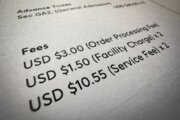Many Americans have stopped using the U.S. Postal Service in favor of private carriers like UPS and FedEx. And now, it seems, so has the federal government.
In fact, despite spending $337 million last year on shipping, federal agencies only gave the financially troubled Postal Service $4.8 million in business – less than two percent.
“Although its competitors have consistently captured more than 98 percent of shipping revenue from federal agencies through GSA contracts, the Postal Service has opportunities to increase its share of this market,” said a report by the agency’s Office of Inspector General.
One of the biggest hurdles is that the USPS waited eight years before it joined a competitive-pricing program for other federal departments, the IG said. By that point, private carriers already had agreements with many different agencies.
The General Services Administration handles many contracts and business partnerships for the federal government. But while FedEx and UPS have partnered with the GSA since 2001, the Postal Service didn’t get involved until May 2009.
“Consequently many federal agencies have long-term relationships with competitors and are reluctant to switch to the Postal Service,” the inspector general said.
And the service has not started two- and three-day guaranteed express delivery, which many government agencies need, the IG said, even though the Postal Service’s Priority Mail met these requirements 90 percent of the time.
“Adding a two- and three-day guaranteed service product would position the Postal Service to successfully bid on future domestic delivery services contracts,” the report said.
The rewards of meeting the challenges could be well worth it for the cash-strapped mail service. Investigators estimated the Postal Service could get $34.8 million more each year from government shipping in 2013 and 2014.
Postal Service representatives said they are working to expand their presence in the federal government shipping market, but disagreed with the assumption that millions could be waiting if the agency changed some of its policies.
“Without more detailed data on the characteristics of federal shipments (weight, size, zone, origins, destinations, service levels), it is nearly impossible to predict a value for Postal Service potential,” said a response from Postal Service officials. Representatives for USPS declined to comment further.
One of the biggest challenges the Postal Service faces is out of its hands. Federal law requires that its products cover their costs.
“Unlike competitors, the Postal Service cannot sell products below cost and make up the loss with other products or services to penetrate a market, attract new customers, or match competitors’ prices,” investigators noted.
That left the Postal Service sometimes cheaper, but often more expensive than its competitors.
“Both FedEx and UPS offered significantly lower prices on next day express delivery of packages,” the IG report said. The Postal Service is cheaper for local deliveries, but “for longer distances, FedEx and UPS have a price advantage over the Postal Service.”
Other obstacles to getting government business are more difficult to overcome. The Department of Defense, for example, gives preference to carriers that have their own aircraft and would be willing to let the government use them in a national emergency under the Civil Reserve Air Fleet program.
“Because the Postal Service does not own aircraft, it is prohibited from competing for DoD business allocated to CRAF participants, even when demonstrating lower prices,” investigators said.







